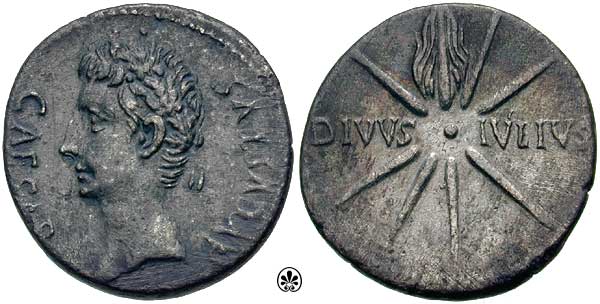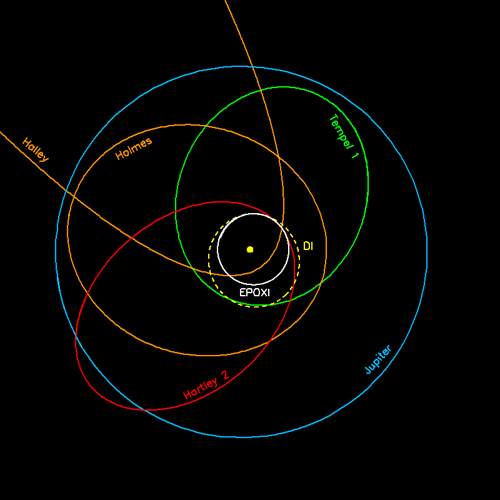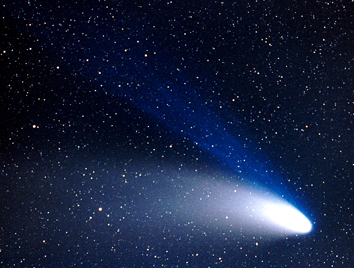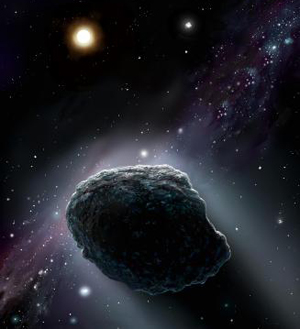 Dark Comet in 2012?
Editor: In the past, I've warned that the Mayan Calendar is not the reason many scientists believe that something bad will happen to Earth in the year 2012. After all, it's just a stone with dates on it. But the fact that it ends on December 21, 2012 is significant because of a number of ominus celestial events that are known scientifically to be troublemakers. These are covered in my article 2012: Doomsday on Viewzone. But, just as important as the end date of the Mayan Calendar is the date that it begins -- the year 3114 BC. Here is an interesting article by Robert Bast, reprinted with his permission. Dark Comet in 2012?
by Robert Bast
When considering what might cause us grief in 2012, few if any researchers consider the start of the Mayan Long Count calendar to have any importance. This is surprising, because the reason for the calendar beginning on August 11 3114BC might contain clues about 2012 itself. After all, the Mayan culture did not exist 5,000 years ago, so either they randomly chose an ancient date on a whim, or an earlier civilization was behind the calendar, and they knew something important occurred on that date. What could happen in 3114BC, and also in 2012AD? No civilization has lasted that long, so they are unlikely to be man-made events. Any natural events that occur so infrequently on Earth are virtually impossible to predict (volcanic eruptions for example). So that leaves us with astronomical events. The astrology of the pair of dates has been well studied, so we can rule out alignments of the stars and planets. That leaves the Sun, which we barely understand today, and comets. Is there a comet with a periodicy of 5000 years, due to return in 2012? Without any evidence from 3114BC it is impossible to say. Given that we are now near the end of the Mayan 5th age, could their calendar be designed to cover five orbits of a comet? And end catastrophically in 2012? Most people have not heard of Comet Caesar (it doesn't even have a Wikipedia entry), and hopefully this will remain so. However, if we are to suffer a terrible tragedy in 2012, it is currently my leading candidate, and the purpose of this article is to explain why. Comet Caesar Comet Caesar was the most famous comet of its day, and one of the brightest ever witnessed. It was visible during an annual Roman festival held in 44BC, shortly after Julius Caesar's death. The following quotes are from The Greatest Comets in History: Broom Stars and Celestial Scimitars by David Seargent: This was the comet that blazed in the skies of Rome following the assassination of Julius Caesar and which became immortalized by the Romans on the reverse of a coin [Top of page] bearing a portrait of Augustus struck in honor of the great Julius. According to Pliny, Octavian wrote that: "On the very days of my games, a comet was visible over the course of seven days, in the northern region of the heavens. It rose at about the eleventh hour of the day and was bright and plainly seen from all lands"Comet Caesar is a parabolic comet -- a comet that returns less frequently than every 200 years. Most parabolic comets have orbits significantly longer than 200 years, and very few have ever been observed to make a complete orbit.[1] Astronomers expect 50 percent of parabolic comets will receive gravitational nudges that cause them to never orbit the Sun again. Those that remain in orbit should be slowed with each passage, eventually becoming intermediate or short-period comets.[2] Therefore we either never see them again, or they take so long to return that we don't know which, if any, have historical records they match up with.  [Above:] Some orbits of short-term comets. In my search for the most likely 2012 culprit, I have constantly asked myself, could the ancients have predicted this? Asteroids and comets are definitely predictable in a broad sense, and all that it takes is observation and mathematics. Such calculations are not easy. They require recalculating the orbit for every day of every year, according to where the object is then located, and how the planets are affecting its course. If ancient astronomers had considered the period of a comet or asteroid to be fixed, rather than varying due to the gravitational influences of planets, then there may have been inaccuracies in any 2012 prediction they made. However the daily recalculations were certainly not impossible in ancient times. Predictability of Comets Perhaps the most famous comet, even today, is Halley's Comet. Edmond Halley - as well as a team of French mathematicians -- predicted the return of this comet, not just from knowing the dates of its past visits, but by calculating the gravitational effects of planets like Saturn and Jupiter. They did this by hand. A single line in the Talmud suggests that 1st century Jewish astronomers were also aware of the periodicy of Halley's Comet:
"...a star which appears once in seventy years that makes the captains of the ships err."To go from calculating the return of a comet, to having knowledge that it will probably strike Earth, is a major leap. Although that is not to say they weren't merely predicting the return of a spectacular comet, let's investigate the possibility that an ancient culture was capable of predicting the actual impact of a comet in 2012. First of all, for this hypothesis to have any validity, the comet must be a long period one; that is, it must pass our planet less frequently than once every 200 years. More frequent comets would be well known by modern astronomers, and would most likely have their future orbits determined. According to Wikipedia, there are just 40 known comets with a periodicy greater than 200 years (or non-periodic comets). Of these, 38 have been observed since 1577AD. The only prior dates were 1106AD and 44BC. To me this suggests that a great many earlier observations would have been made, we just don't have evidence of such. The Great Comet of 1106AD was seen from Europe to Japan. A Welsh text said of it: "In that year there was seen a star wonderful to behold, throwing out behind it a beam of light of the thickness of a pillar in size and of exceeding brightness."--wikipedia.org/wiki/X/1106_C1  Were we to have detailed records of comets from more historical times, we might have a similar description with which we could determine the periodicy of the 1106 comet. Without this, we have nothing to base its return on -- could be tomorrow, could be never.[3] Were we to have detailed records of comets from more historical times, we might have a similar description with which we could determine the periodicy of the 1106 comet. Without this, we have nothing to base its return on -- could be tomorrow, could be never.[3]You could say the same about Comet Caesar, the aforementioned earliest recorded comet of 44BC. Without another record of it, we cannot determine when it will return next. While there may not be any surviving record of a prior passage, perhaps we can make an implication from the Long Count calendar. If the end of the calendar is actually the date a comet will strike Earth, what is the most logical reason for the start date? If, and this is obviously pure speculation, it had been observed in 3114BC, and again in 44BC, could it be returning once again in 2012? With a precise periodicy of 1025.2 years we get the following sequence of dates:
Is 39BC close enough to 44BC? In 1758 the French astronomers who calculated the return of Halley's Comet determined that the gravitational effects of Saturn and Jupiter would make a difference of 618 days to its existing orbit, or almost 2 years. Is a difference of 5 years within 5 orbits outside the realms of possibility? Variable Periodicy of Comets When Comet Hyakutake was discovered in 1996, astronomers determined that on the way in to our solar system it had an estimated periodicy of 17,000 years, yet after having its orbit disturbed by the largest planets, its new course meant it would take between 72,000 and 114,000 years to return. When 23P/Brorsen-Metcalf was first discovered it was closest to Earth in August 1847. After completing its orbit it was back in that approximate spot in October 1919, and again in August 1989. The two observed periods were 72 years and 70 years. That's roughly a 3% deviation between 2 orbits. The periodicy of a comet can vary from a little, to a lot, to so much we never see it again. It is entirely possible that Comet Caesar was seen the very same years as the Great Flood, the end of the Eygptian New Kingdom, the start of the Long Count calender - and will return in 2012. Where are the records?
"...they were either not observed or were observed and recovered by illiterate, uneducated peasants. It was quite unthinkable that the sophisticated urban theologian of A.D. 1000... should take seriously the allegations of such rabble that stones fell from the sky."To explain the absence of records for Comet Caesar prior to 44BC is easy -- lost in the annals of history that never made it. But what of 987AD? Could it really go from observed in 44BC, to not observed at all? Or has the record from 987AD +/-3 years, just disappeared? The former possibility is covered by the concept of dark comets, described below. To answer the latter possibility, 987 was in the Dark Ages, renowned for a lack of records. In fact so lacking that some researchers have speculated that the era never existed at all! Halley's Comet was observed in 837 according to records from Japan, China, and Germany. The next observation was in 912, and was recorded in the Annals of Ulster, like this: "A dark and rainy year. A comet appeared”. There is no specific record of its return in 990, and was next spotted in 1066, where it was recorded as having an influence on the Battle of Hastings.  [Above:] King Harold and nation cower in fear at the close passage of Halley's Comet (picture from part of the Bayeux Tapestry; more pictures at The Bayeux Tapestry Gallery). The only mention of a comet circa 987AD (when I approximately hypothesize Comet Caesar would have returned) is indirect, and attributed to Eilmer of Malmesbury, a Benedictine monk: "You've come, have you? -- You've come, you source of tears to many mothers. It is long since I saw you; but as I see you now you are much more terrible, for I see you brandishing the downfall of my country..." --wikipedia.org/wiki/Eilmer_of_MalmesburyHe described this appearance in 1066. Because the previous passage of Halley's Comet would have been in 990AD, and he was an "old man" in 1066, it is believed that he could have seen the comet when he was 5 years old, and have would been 76 years old in 1066 when he was quoted. But what if he was just a few years older in 1066, and was actually recalling a comet he witnessed in 987AD? Could he have seen the most recent passing of Comet Caesar, and not Halley's Comet, in the closing years of the tenth century? Taking a different angle, if there is no specific record of Halley's Comet in 990AD, it fits that a return of Comet Caesar circa 987AD also avoided any record that survives to this day. For some, a simple lack of record will suffice, and the hypothesis is feasible. For the others, I will describe a mechanism from which the comet rapidly loses visibility. Dark Comets There's only one difference between dark comets and regular comets -- we won't see the approach of the dark comet. In early 2009 many news articles reported the findings of British astronomers Bill Napier (Cardiff University) and David Asher (Armagh Observatory), and reading them sent a shiver down my spine, prompting me to research the possibilities further. "There is a case to be made that dark, dormant comets are a significant but largely unseen hazard," says Napier.
"...periodic comet showers appear to correlate with the dates of ancient impact craters found on Earth, which would suggest that most impactors in the past were comets, not asteroids.Now Napier and Asher warn that some of these comets may still be zipping around the solar system. Other observations support their case. The rate that bright comets enter the solar system implies there should be around 3000 of them buzzing around, and yet only 25 are known.[5] Until now it was commonly accepted that more than 90% of meteors and comets that could cause us harm were known and tracked by astronomers and government agencies. That thousands of comets that are potentially heading straight for us are not known or tracked is rather frightening. How can a comet become dark? The science is actually quite easy to understand. Comets start out with ice on their surface. Every time they orbit around the Sun, the heat melts some ice. Eventually there is no ice left. And the only way we can easily see comets is from light reflecting off the ice. In 1983, Comet IRAS-Araki-Alcock passed by Earth at a distance of 5 million kilometres, the closest known pass by any known comet for 200 years. It was spotted only two weeks ahead of its closest approach. "It had only 1 per cent of its surface active," says Napier. Comet Borrelly, visited by NASA's Deep Space 1 probe in 2001, was found to have extremely dark patches over much of its surface.[6]
Here are a couple of examples of lost comets. One of the reasons they are no longer observed could be that they have lost their luminosity. * 18D/Perrine-Mrkos -- seen in 1896 and 1909, then 1955, then 1969, and not since. * 5D/Brorsen -- first spotted in 1846, last seen in 1879. With an orbital period of 5.5 years. Has been as close as 0.52 AU to Earth, and as far as 1.5AU. Japanese astronomers hoped to spot it in 1976, but failed. The orbital period of 5D/Brorsen suggests it could be passing by in 2012, if it is still on course. There is even a possible case of a dark comet harming us (in a roundabout way) in recent times. Paul Wiegert of the University of Western Ontario has determined that the dark comet D/1895 Q1 (Swift) collided with NASA's Mariner 4 Mars probe in 1967. Given that the comet was only ever observed in 1895/1896, there is not enough data to be absolutely certain, but something took out the probe, and a dark comet is the leading candidate. Many lost comets could be coming close to Earth in 2012, but without recent observations, there is no way of accurately calculating their passage. A long period comet would be the best candidate for a 2012 culprit for two reasons: * an ancient civilization may have tracked comets for much longer than our present civilization, giving them a great advantage in determining the periodicy of long period comets * a longer period that adds up to a 2012 rendezvous is more statistically reliable than that of a short period comet. Every passage increases the chance of permutations due to encounters with the gravity of planets it may pass. A comet that has orbited 4 times in the last 2000 years is more likely to still be on course that one that has orbited unseen 50 times in the last 200 years. Summary Even without the possible return of Comet Caesar, dark comets are the leading contender for triggering a predictable 2012 cataclysm. Comets were known to the ancients - we have many ancient texts providing us with descriptive names like "fire from the sky" -- and their cyclical nature makes it easy for any civilization with mathematical prowess to predict. Thousands of hypothetical dark comets remain undiscovered in modern times, and if we do find one on a collision course with our planet, we may only have a few years, or even a few days, to prepare. And those times will be times of mass panic. Notes 1. Steel, Rogue Asteroids and Doomsday Comets, 25. The longest observed orbital period for a comet is 153P/Ikeya-Zhang with 341 years, having been discovered in 1661, and again in 2002. 2. Gribbin, Fire on Earth, 103 3. Of course there is the possibility that the Great Comet of 1106AD and the 44BC comet are one and the same. If that were true, it could be expected to return circa 2250AD. 4. Lewis, Rain of Fire and Ice, 17 5. Parsons, "'Dark' comets may pose threat to Earth." 6. Ibid.
|

 Clark Chapman, from the Southwest Research Institute in Boulder, Colorado, is not so concerned, saying that the dark comets 'would absorb sunlight very well' and therefore should be possible to detect from the heat they would emit. I'm not qualified to judge this statement, but from a layman's point of view, I would think a handheld mirror reflecting the sun's light from a mile away is far more easily seen than a slab of rock that is so hot you could fry an egg on it.
Clark Chapman, from the Southwest Research Institute in Boulder, Colorado, is not so concerned, saying that the dark comets 'would absorb sunlight very well' and therefore should be possible to detect from the heat they would emit. I'm not qualified to judge this statement, but from a layman's point of view, I would think a handheld mirror reflecting the sun's light from a mile away is far more easily seen than a slab of rock that is so hot you could fry an egg on it.